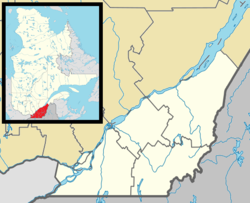Tring-Jonction
Tring-Jonction | |
|---|---|
 View from Saint-Frédéric. | |
| Motto: Si bien chez nous | |
 Location within Beauce-Centre RCM. | |
| Coordinates: 46°16′N 70°59′W / 46.267°N 70.983°W[1] | |
| Country | |
| Province | |
| Region | Chaudière-Appalaches |
| RCM | Beauce-Centre |
| Constituted | November 21, 1918 |
| Named after | Tring[1] |
| Government | |
| • Mayor | Mario Groleau |
| • Federal riding | Beauce |
| • Prov. riding | Beauce-Nord |
| Area | |
• Total | 27.30 km2 (10.54 sq mi) |
| • Land | 27.32 km2 (10.55 sq mi) |
| Population (2021)[3] | |
• Total | 1,526 |
| • Density | 55.9/km2 (145/sq mi) |
| • Pop 2016-2021 | |
| • Dwellings | 687 |
| Time zone | UTC−5 (EST) |
| • Summer (DST) | UTC−4 (EDT) |
| Postal code(s) | |
| Area code(s) | 418 and 581 |
| Highways | |
| Website | www |
Tring-Jonction (French pronunciation: [tʁiŋ ʒɔ̃ksjɔ̃]) is a village in the Beauce-Centre Regional County Municipality in the Chaudière-Appalaches region of Quebec, Canada. Its population is 1,526 as of 2021.
It is named after Tring, a town in Hertfordshire, England. "Jonction" refers to the Quebec Central railway station that was built in 1881.[1]
History
[edit]Tring-Jonction was founded in 1918 by Ephrem Lagueux by splitting away from Saint-Frédéric-de-Beauce.
Demographics
[edit]In the 2021 Census of Population conducted by Statistics Canada, Tring-Jonction had a population of 1,526 living in 657 of its 687 total private dwellings, a change of 5.4% from its 2016 population of 1,448. With a land area of 27.32 km2 (10.55 sq mi), it had a population density of 55.9/km2 (144.7/sq mi) in 2021.[4]
|
|
| |||||||||||||||||||||||||||||||||||||||||||||||||||||||||||||||
| Population counts are not adjusted for boundary changes. Source: Statistics Canada[5][6][7][8] | |||||||||||||||||||||||||||||||||||||||||||||||||||||||||||||||||
References
[edit]- ^ a b c "Banque de noms de lieux du Québec: Reference number 63661". toponymie.gouv.qc.ca (in French). Commission de toponymie du Québec.
- ^ a b "Répertoire des municipalités: Geographic code 27060". www.mamh.gouv.qc.ca (in French). Ministère des Affaires municipales et de l'Habitation.
- ^ a b "Census Profile, 2021 Census, Statistics Canada - Validation Error".
- ^ "Population and dwelling counts: Canada, provinces and territories, and census subdivisions (municipalities), Quebec". Statistics Canada. February 9, 2022. Retrieved August 28, 2022.
- ^ Cite error: The named reference
SCref21was invoked but never defined (see the help page). - ^ 1996, 2001, 2006, 2011 census
- ^ Cite error: The named reference
census1971was invoked but never defined (see the help page). - ^ Eighth Census of Canada 1941 - Volume II - Population by Local Subdivisions (Report). Dominion Bureau of Statistics. 1944. CS98-1941-2.

